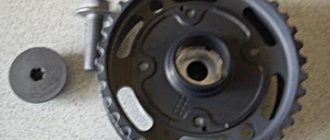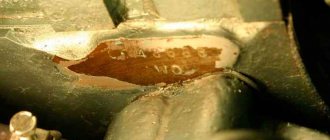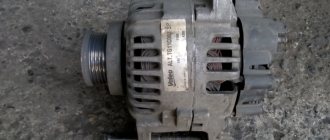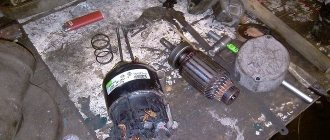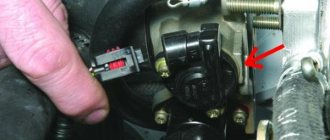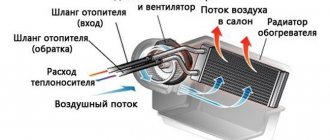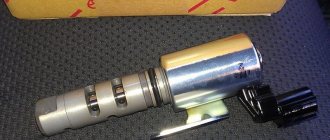The engine operating mode is adjusted using an oil valve and a sensor. Thanks to the electromagnetic control valve, oil is supplied under pressure to the camshaft phase regulator. When the supply of control voltage from the ECU to the solenoid valve stops, the Renault Megane 2 phase regulator returns the camshafts to a position at which there is minimal lag of the intake valves, which leads to the achievement of maximum torque effect at low speeds.
Phase regulator malfunction
Malfunctions of the phase regulator may include the following: it begins to make unpleasant cracking sounds, freezes in one of the extreme positions, the operation of the solenoid valve of the phase regulator is disrupted, and an error is formed in the ECU memory.
Although you can drive with a faulty phase regulator, you need to understand that the engine will not operate in optimal mode.
This will affect fuel consumption and engine performance. Depending on the problem that has arisen with the clutch, valve or the phase regulator system as a whole, the symptoms of the malfunction and the possibility of eliminating them will differ.
Chevrolet Aveo phase distribution valve maintenance process
- We stop and turn off the car.
- Open the hood and disconnect the negative cable from the battery.
- Disconnect the wire connectors from the solenoid valves. The valve location diagram is in the photo below.
- Unscrew the mounting bolt on each of the valves. The original solenoid valves are secured with a bolt with an E8 head. Not every household has keys for unique E - Torx .
Many craftsmen complain that the bolt on the far valve is very, very inconvenient to unscrew. Be sure to use an extension for the socket heads. You may even need a cardan.
- We take out the solenoid valves . Please note that a hole will appear at the site of each valve, which is best plugged with a clean rag . The valves can be seated with slight interference. There are times when it takes quite a lot of effort to remove the electrovalves. If any of the valves cannot be removed manually, you can use pliers.
- We replace valves.
Operating principle of the phase regulator
To understand why the phase regulator cracks or its valve jams, it makes sense to understand the principle of operation of the entire system. This will give a better understanding of breakdowns and further actions to repair them.
The engine does not perform the same at different speeds. Idle and low speeds are characterized by so-called “narrow phases”, in which the exhaust gas removal rate is low. Conversely, high speeds are characterized by “wide phases”, when the volume of gases released is large. If “wide phases” are used at low speeds, then the exhaust gases will mix with the newly incoming ones, which will lead to a decrease in engine power, and even stop it. And when “narrow phases” turn on at high speeds, it will lead to a decrease in engine power and its operating dynamics.
There are several types of phase control systems. VVT (Variable Valve Timing), developed by Volkswagen, CVVT - used by Kia and Hyindai, VVT-i - used by Toyota and VTC - installed on Honda engines, VCP - Renault phase regulators, Vanos / Double Vanos - system used in BMW. Next, we will consider the principle of operation of the phase regulator using the example of a Renault Megane 2 car with a 16-valve K4M engine, since its failure is a “childhood disease” of this car and its owners most often encounter a non-working phase regulator.
Control occurs through a solenoid valve, the oil supply to which is regulated by electronic signals with a discrete frequency of 0 or 250 Hz. This entire process is controlled by an electronic control unit based on signals received from engine sensors. The phase regulator is switched on when the engine load increases (rpm value from 1500 to 4300 rpm) when the following conditions are met:
The phase regulator returns to its original position when the speed decreases under the same conditions, but with the difference that zero phase shift is calculated. In this case, the locking plunger blocks the mechanism. Thus, the “culprits” for a malfunction of the phase regulator can be not only the phase regulator itself, but also the solenoid valve, engine sensors, malfunctions in the motor, and malfunctions of the ECU.
Peugeot 308 timing belt - features of operation and replacement of the phase solenoid valve
The gas distribution system of any vehicle is designed to timely supply a combustible mixture or air to the cylinders of the power unit with the subsequent release of exhaust gases. Different motor operating modes have a certain duration when the valve is in the open or closed position. This made it possible to change power and torque parameters in various operating modes of the power unit, as well as reduce exhaust toxicity.
Simply put, the main purpose of the gas distribution system for changing the phases of the Peugeot 308 and 307 is to maximize the optimization of the operation of the car engine in different modes: idling, at peak power and maximum torque, as well as for the purpose of reverse regulation of exhaust gases.
Dismantling and cleaning the phase regulator
The operation of the phasic can be checked without dismantling. But to check the wear of the phase regulator, it must be removed and disassembled. To find where it is located, you need to navigate along the front edge of the camshaft. Depending on the design of the motor, dismantling the phase regulator itself will differ. However, in any case, the timing belt is thrown through its casing. Therefore, access to the belt must be provided, and the belt itself must be removed.
After disconnecting the valve, always check the condition of the filter mesh. If it is dirty, it needs to be cleaned (rinsed with cleaner). To clean the mesh, you need to carefully move it apart where it snaps into place and remove it from its seat. The mesh can be washed in gasoline or other cleaning liquid using a toothbrush or other non-rigid object.
The phase regulator valve itself can also be cleaned of oil and carbon deposits (both outside and inside, if its design allows) using a carb cleaner. If the valve is clean, then you can proceed to check it.
Replacing the timing belt on a 1.6 liter K4M petrol engine
- Files
- Engine
The timing belt is changed every 60,000 kilometers or every 4 years, even if the mileage is less than 60. Rubber has its own service life.
This article describes the process of replacing the timing belt using the example of a Renault Fluence K4M gasoline engine, 1.6 liter, 16-valve, 106 hp.
Operating procedure
You purchase a kit for replacing the timing belt (belt, rollers, bolts), and according to the regulations, you are also required to change the plugs.
You can find out the cost and codes of Renault spare parts for maintenance from our partners (existence, emex, autodoc, etc.), who provide discounts using the Renault-Drive card
It is recommended to carry out the work of replacing the timing belt and rollers at a service center or if you have sufficient experience.
Raise the car and remove the front right wheel. Remove the engine protection and the right fender liner.
Using a jack, lift the engine, resting on the pan closer to the crankshaft pulley.
Unscrew the upper mount of the engine mount and the supporting support.
Next, you need to disconnect the fuel line fitting and move it to the side.
Then remove the plug from the end of the intake camshaft (which is larger in diameter than the others).
How to check the phase regulator
There is one simple method for checking whether the phase regulator is working in the engine or not. To do this, you only need two thin wires about one and a half meters long. The essence of the check is as follows:
The phase regulator solenoid valve must be checked using the following algorithm:
The resistance can be measured without dismantling, but the mechanical component of the valve must also be checked. For this you will need:
Phase regulator error
If on Renault Megane 2 the control unit has generated error DF080 (camshaft characteristic change circuit, open circuit), then you must first check the valve using the above algorithm. If it works normally, then it is necessary to “ring” the wire circuit from the valve chip to the electronic control unit.
Error codes and solenoid valve replacement
If it was noticed that during the process of gaining power by the Peugeot 308 engine, the car begins to twitch, and the on-board computer displays an error message, the phase adjustment valve of the Peugeot 308 may have failed. This can be confirmed by error codes P0013 and P0014 received after diagnosing the engine.
If the phase valve malfunctions, a check engine error will immediately appear on a Peugeot car, followed by the engine switching to emergency operation.
The interpretation of received errors after diagnostics may mean the following:
- The phase solenoid valve is broken, which is why there is no full oil supply to the phase shifter. Because of this, the exhaust camshaft does not rotate to the set angle. In such a situation, it is necessary to replace the failed part.
- The sealing rings that seal the oil lines have been damaged. To eliminate the damage, they need to be replaced.
- The wiring of the exhaust camshaft position control sensor is damaged, causing incorrect data to be sent to the electronic control unit. To repair, you need to check the connection of the terminal contacts on the sensor.
Replacing the timing system solenoid valve of a Peugeot 308 consists of the following simple steps:
- The terminals on the battery are disconnected.
- The connector on the solenoid valve is disconnected.
- The mounting bolt is unscrewed.
- The broken solenoid valve is removed.
- A new spare part is inserted and the mounting bolt is tightened.
- All disconnected wires are connected in their places.
By replacing the solenoid valve on a Peugeot 308, you can restore acceleration dynamics, stabilize engine speed, reduce exhaust gas levels and, of course, remove the error on the on-board computer display.
Disabling the phase regulator
Many car enthusiasts are concerned about the question: is it possible to drive with a faulty phase regulator? The answer is yes, you can, but you need to understand the consequences. If for some reason you decide to turn off the phase regulator, then you can do it like this (considered on the same Renault Megane 2):
Conclusion
Automakers recommend changing phase regulators every 100...200 thousand kilometers. If it knocks earlier, first of all you need to check its valve, as this is easier. It is up to the car owner to turn off or not turn off the phasic, as this leads to negative consequences. Dismantling and replacing the phase regulator itself is a labor-intensive task for all modern machines. Therefore, you can only perform this procedure if you have experience and the appropriate tools. But it is better to seek help from a car service center.
Source
How to install a new RFG mechanism
A separate story is the work not only on monitoring the condition of the phase regulator oil seal, but also the procedure for installing the new RFG mechanism on the Renault Megane 2. This aspect is quite well discussed in various thematic video reviews. Such a process requires high qualifications, so you should contact a car service to perform it.
If there is no specialized organization that can carry out high-quality work, you can do the repair of Renault Megane 2 yourself. However, it is necessary to carefully approach the issue of studying the video in this direction and follow the order of work when replacing the phase regulator.
First, the oil seal is removed as indicated above. The Renault Megane 2 engine is jacked up using a special “claw” or an identical object. Afterwards, the engine stops at the coincidence of the camshaft and crankshaft marks. The rollers and timing belt drive are dismantled. Afterwards, the fasteners are unscrewed and the phase regulator is removed.
Renault Megane Meganych › Logbook › Phase regulator valve. Unclear…
Hi all! I realized that my phase regulator is not working. There is no diesel in the morning, but if you look at Piren, something like this opens up:
SCO 99.9, Need 12, in fact 1-2. By the way, these 1-2 actually appear if you turn on the gas at a low coolant temperature, that is, when the phase regulator is not yet turned on (SCO 0). This can indicate that the phase regulator is not working. Moreover, if you increase the throttle to 4k, then the values, on the contrary, become larger than necessary. There is, of course, a possibility here that the phase adjustment turns off a little earlier, and the tooth does not have time to transmit the correct values. The timing belt was changed 3k ago, the phasic itself most likely never changed. I decided to remove the valve, see if there was any oil there at all, clean it, and change the oil seal - since everything was like this:
Now the most interesting part 1. Oil in the connector. After washing it comes out again. If you start the engine without a valve, oil appears, but not quickly if after a long period of inactivity. If you do it right away, it will splash out 2. There is no net, it looks like it’s under a Kamaz truck. Looks like he was dealing with barbarians.
4. I stupidly threw back the valve chip... and nothing changed, the engine worked as it did, the readings were as crooked as they were, and remained exactly the same. Well, almost nothing - the following error got into alive (I put it back - it went away). Which makes me wonder whether a signal is sent to the valve at all. How to check?
5. On the panel, the service and Jackie Chan did not light up (Jackie Chan never burned out, the service with a pregnant woman burned out) What the hell...
In general, does anyone have any ideas besides the fact that the phasic and the valve are dead. If only they were the problem, then in principle they could be replaced.
Added:
I remove the chip from the valve - there is no check, in others there is. Well, I have an alarm error on the adsorber. Do you get the idea? I look carefully at my own photos... The chip for the valve is black... and the connector is gray, and where is the gray chip? Adsorber! I remove the chip from the adsorber and oops - Injection check, camshaft error. Flipped it around, erased the mistakes - Voila
Added 2:
I took the valve off and cleaned it again. So far it’s working, I gased it on the spot. went to work. The car feels more responsive and smoother, most noticeable in 2nd gear. Consumption has dropped slightly. The valve in the Prince worked, because instead of the adsorber valve, after 3k revolutions the phase regulator valve approximately opened to full))
Source
The role of electromagnetic valves in the operation of the timing system
The power unit of the Peugeot 308 has two phase valves and the 307 has one phase regulator, which is installed in a toothed pulley. Structurally, the pulley has two main parts: an impeller equipped with a blade and a cylinder with a chamber. When the established conditions are reached, the electronic control system sends a signal to the phase solenoid valve. When opened, the valve provides oil supply under a certain pressure through the central channel located on the camshaft. Oil enters through holes in the central part of the impeller and the mechanism that lifts the plunger.
Due to the pressure under which the oil is supplied, the plunger moves upward and the impeller is released. Due to this, the impeller and the phase control device rotate in the direction of delaying the operation of the intake valves. After removing the voltage from the solenoid valve, the blade and impeller return to their original position, and the plunger locks the entire system in a state of minimal lag.
The valve is responsible for ensuring the flow of oil to the phase control device. After turning off the control potential on the electromagnetic device, the phase regulator moves the camshaft to a state with the least lag, thereby ensuring maximum torque at low speeds.
On Peugeot 307 and 308, phase regulators mounted on camshafts function normally if the following parameters are met:
- at crankshaft speeds above 1500 rpm;
- when the pressure in the intake pipe reaches over 500 mbar;
- at antifreeze temperatures above 30 degrees.
The ECU is involved in changing the valve timing, which reads the location of the crankshaft and camshaft, the temperature indicators of the antifreeze, as well as the speed of the vehicle. The ranges for adjusting the rotation angles and camshaft at idle speed vary from +5 to -5, and with a sharp increase in speed, from 0 to 30 degrees.
Renault phase control valve
The solenoid valve that controls the operation of the phase regulator can cause uneven operation of the engine at idle and negatively affect the dynamics of the car and fuel consumption. Today we will look at why this happens and talk about troubleshooting problems that arise due to malfunction of the phase shifter valve on a Renault Megane 2 car.
What determines the service life of phase regulator parts?
Most owners of Renault Megane 2 cars with 16-valve K4M and F4R engines neglect the phase regulator valve seal (also called a phase shifter, or in car enthusiast slang, “phasor”). And in vain, because the cleanliness of all components of the control device, and therefore its performance and service life, depends on the condition of the oil seal.
The phase regulator solenoid valve is located in the front of the Renault engine, and in addition, it is installed in a recess - in the place where dirt first accumulates. If the oil seal dries out or is damaged, dust and sand mixed with engine oil enter the valve channels and the working cavity of the rotary assembly. This is fraught with jamming of the electromagnetic device and accelerated wear of the chambers and blades of the phase regulator itself. In this case, excessive clearance may appear, or even damage to individual parts of the device, which is responsible for changing the valve timing.
As a result, instead of replacing the phase regulator oil seal at a cost of several hundred rubles, you have to buy parts with a total cost of more than 20 thousand rubles. For this reason, experts recommend periodically inspecting the condition of the seal and replacing it at the slightest suspicion.
Megan_2 does not find the starting point with the phase regulator.
#1 STimon
Attention! I'm just the owner of an old car!
- Users
- 6 messages
- City: Ryazan region.
- Gender: Man
I would be very grateful for the KV+RV oscillogram for Megan_2 2005, 1.6 liters, 16 valve, Sagem S3000 block. I can’t find the reason for the errors in setting the initial position of the phase regulator. The positions of the RF and CV are according to the templates, the valve and sensor of the RF are working, clean, when voltage is applied to the XX voltage to the phase regulator control valve, the machine stalls, i.e. The FR itself works. Despite all this, he cannot find the starting position! Suspicion of a glitch in the ECU.
What leads to this idea is that the numbers that should be on the measurement channels of the position of the PV are not fully recorded and the position of the PV reads 52-53 degrees, instead of the required 20. There was a suspicion that the target of the PV sensor was rotated. I found one oscillogram on the Internet (and many links to the same one) that seems to correspond to what I have, but suddenly. This is the idea I would like to test with your help. I’ll post photos of the oscillograms a little later, they’re at home.
Best regards, Dmitry.
PS: I thought the settings file was a biscuit, I want to try to compare it with a similar one, maybe someone has a damos for this block? Or at least addressing, where the control and calculation of the phase regulator is prescribed.
- Top
- Nickname or quote
How does the phase regulator valve work?
Signs of a malfunction of the phase regulator valve and its jamming in the open position are indicated by the lack of idle speed and unstable engine operation. To understand why this happens, let's look at the mechanism of operation of the phase shifter.
Initially, the “phasor” valve is closed, that is, gaps between the rod and the body are present in the lower part of the device. In this case, the engine oil puts pressure on the phase shifter blades and holds its rotating part in its original position.
As soon as the solenoid receives power, the valve stem is pushed down and oil begins to flow through other channels. In this case, pressure appears on the phase regulator blades from the reverse side, which in turn contributes to the displacement of the timing gear relative to the camshaft - this is how the valve timing is changed.
Valve sticking open will be especially noticeable at idle or low speed, that is, when the camshaft and gear should be in the zero position. Due to the phase shift, the intake valves close with a delay.
At high speeds this does not affect the filling of the cylinders, since the inertia of the gas flow plays a role. But in idle mode, late closing of the intake valves leads to partial displacement of the working mixture from the cylinders, which leads to uneven operation and a decrease in torque.
Something else useful for you:
Design and principle of operation
RFG (valve timing regulator) is a mechanism with a sensor that determines the position of the camshaft, oil pressure, temperature, speed, and also closes and opens the oil valve, due to which the camshaft moves relative to its axis, and the operation of the power unit changes.
The main sign that a part needs to be replaced is if traction is lost during acceleration, while oil and fuel consumption increases, and mechanical wear of parts occurs in the engine.
How to check the serviceability of the Renault phase regulator
The performance of the Renault Megane II phase regulator valve is checked in two stages. First of all, conclusions should be drawn about the serviceability of the solenoid coil. To diagnose faults in the electrical part of the device, you will need a multimeter. By the way, you can carry out the necessary measurements without removing the valve from the engine - just disconnect the block connecting it to the electronic control unit (ECU).
With the tester in the mode for measuring tens of ohms, touch the probes to the contacts in the valve connector.
Engine crackling
If the crackling noise is heard only when the starter turns, then this is not a problem. The reason is wear of the bendix, or in the worst case, the flywheel. But if the crackling noise continues with the engine running, then read on.
For the most part, this article concerns Renault of the following models Clio, Megane 2, Megane 3, Duster and Fluence , but if you have another foreign car with a phased engine, then most likely the problem is the same as in these car models.
So, you hear a characteristic crackling sound in the engine , especially on a cold car and your engine has a phase regulator, then most likely this is wear on the phase regulator itself (in about 80-90% of cases this is the case) and perhaps the phase regulator valve is also faulty.
Depending on how long you drive with such a crash, you may end up with very expensive repairs if you don’t fix the problem immediately.
If the check-engine does not light up, then you may still be in luck, since you can still “save” the phase regulator valve. Replacing the phase regulator is not a cheap procedure and it is better to combine it with replacing the timing belt. The valve is also not cheap, so it’s better to take it to a service center for diagnostics - you can’t drive like that.
You can find out the cost of the phase regulator and its replacement, read the reasons for failure and understand what to do next with the engine here.
But don’t despair 10-15% that the reason may be different.
In any case, if you have a Renault , come to our Renault163 :
We’ll help, we’ll fix it, we’ll do the correct diagnostics of the engine, we’ll try to do as little as possible, because we understand that if you drive like that, repairing the engine will be very expensive .
Source
What to do when error DF080 appears
Very often, malfunctions in the operation of the Renault Megane 2 electromagnetic phase regulator cause error DF080, which, when a diagnostic scanner is connected, is indicated as a malfunction in the circuit for changing the camshaft characteristic. The appearance of an error of this type indicates a malfunction in the operation of the phaser solenoid valve or an open circuit in its connection to the electronic control unit.
To eliminate it, you must first check the serviceability of the valve (we talked about how to do this above). If it works normally, then the cause of the error is poor contact or open circuit. In this case, it is necessary to disconnect the connection block of the electromagnetic device and test the circuit from the valve to the computer with a multimeter. If the device shows a break in one of the conductors, then first of all you should inspect the transition harness from the engine to the control unit. Experts talk about it as the most problematic and vulnerable place.
If the continuity test of the chain shows that it is working properly, the cause of the malfunction should be sought in the block itself, in the contact part. As practice shows, over time the connector pins lose their elasticity. This happens especially often after repeated removal and connection of the block to the valve. To restore contact, you need to disassemble the block, remove the terminals and tighten their contact parts using a thin screwdriver or an awl.
Please note: in order not to confuse the polarity of the connection, it is best to remove and repair the pins one at a time. Also, note that each terminal has a miniature latch that holds the contact part in the block. You should not use brute force - the contact part will be removed without problems as soon as you press the latch with some thin tool.
How to repair RFG with your own hands
How to restore and replace the phase regulator directly with your own hands can be found on various video resources. However, textual content can also reveal the issue with no less detail, which will help identify the sources of the problem, as well as troubleshoot the operation of the phase regulator using improvised means.
One of the reasons is a worn-out valve for shutting off the oil or the RFG oil seal on Renault Megane 2. This idea is suggested by the formation of leaks near the indicator and oil seal, which are clearly visible on videos on this topic. Therefore, you should contact the auto store to purchase the part marked 8200823650.
The decorative insert on the Renault Megane 2 engine is first removed using a standard hexagon. This step begins the valve replacement procedure. Then the valve sensor contact is disconnected. The removed wire assembly is placed to the side.
Afterwards, the end side of the phase control valve is found, which is fixed with a bolt with a diameter of 10, and it is unscrewed. By removing the valve, you can determine the need for repair. This will be indicated by cracks in the housing, corrosion of the RFG connecting terminals, as well as other physical defects that indicate that the unit will soon fail and a new one is needed. You can’t ignore the oil seal, which is a rubberized sealing ring. It is also advisable to replace it.
Usually the oil seal is replaced with a new one. The used sealant must first be removed using a hook or knitting needle. The feasibility of changing it is visually determined. After which, using a wooden block or tube, it is returned to its original place by pressing. The video just shows the second option. Installation of the new RFG valve on the Renault Megane 2 is performed in the reverse order. The part is returned to its place, the bolt is clamped, and the contact from the phase regulator is connected to the standard connection. This is exactly how the phase regulator is replaced.
Why the valve jams and how to clean it
As mentioned above, contamination of the phase shifter valve can cause it to jam, which affects engine performance, vehicle dynamics and fuel consumption. The cause of blockage is most often dirt that penetrates into the device through a damaged oil seal. Dust mixed with engine oil gets into the gap between the housing and the rod, causing the latter to begin to jam. In addition, damage or wear to the plastic vanes of the phase regulator can contribute to jamming. In this case, soft chips are guaranteed to get into the channels of the device and with a high degree of probability can cause it to jam.
Cleaning the phasor valve is easy - you don’t even have to disassemble the device to do this. First of all, remove the protective mesh that is installed on the inlet channel. It is made in the form of a spring ring, which is easily unclenched and removed from the body. Using any suitable spray cleaner (carburetor, brake, injector, etc.), wash the valve body and internal passages. Then you need to dry the parts with compressed air - it is best supplied through the outlet channel. Next, the solenoid terminal is connected to a power source and, using the method described above, the accuracy of operation and complete opening of the valve are checked.
In particularly advanced cases, flushing may not help. Then you will have to flare the housing, disassemble the device and thoroughly clean the Renault Megane 2 phase regulator valve.
After washing and checking the functionality of the valve, it is necessary to install a protective mesh in the groove. Experts recommend carefully melting the edges of its joint with a soldering iron - this will protect the filter ring from moving. All that remains is to return the oil seal to its place and install the valve on the engine.
As you can see, there is no reason to be afraid of error DF080 - even a beginner can cope with the problem. As for malfunctions such as valve jamming or wear of phase shifter parts, it is much easier to prevent them than to eliminate them. Attention to little things like an oil stain around the valve will allow you to restore its tightness in time, which will certainly affect the health of the engine and help save the family budget.
Cleaning the timing valve Hyundai Elantra 4 (HD)
Good day! At the request of readers, I decided to write a short article about cleaning the timing valve on a Hyundai Elantra HD (J4). Where is this phase change valve located and what does it serve?
Just some, including me,
